Sharer: Jin Sui|School**: University of Electronic Science and Technology of China**
brief introduction
Quantum computing promises to provide greater computing power than classical computing for many specific tasks. However, noisy quantum computers are not yet fully fault-tolerant, which has also led to doubts about the practicality of current quantum computing. Recent work from IBM has enabled experiments on a noisy 127-qubit processor and demonstrated capabilities beyond classical computing. These experimental results benefit from advances in coherence and calibration in large-scale superconducting processors, as well as the ability to characterize and control noise on such large devices. In strongly entangled states, quantum computers provide correct results, while mainstream classical approximation methods such as MPS and iso TNS fail. These experiments have demonstrated the ability of recent quantum computers to deal with practical problems.
Related papers
**标题:Evidence for the utility of quantum computing before fault tolerance
作者:**Youngseok Kim, Andrew Eddins, Sajant Anand, Ken Xuan Wei, Ewout van den Berg, Sami Rosenblatt, Hasan Nayfeh, Yantao Wu, Michael Zaletel, Kristan Temme & Abhinav Kandala
**Journal:**Nature volume 618, pages500–505 (2023)
**Published date:** June 14, 2023
01
introduction
It is widely believed that advanced quantum algorithms such as factorization or phase estimation require quantum error correction to demonstrate their advantages. However, whether currently available processors can run other shallow quantum circuits reliably enough to provide advantages on practical problems is hotly debated.
Demonstration of quantum advantage can be achieved by demonstrating that existing quantum devices are capable of performing precise calculations beyond classical simulations. This work focuses on this to demonstrate the advantages of quantum computing, rather than implementing quantum circuits on problems for which acceleration has been demonstrated.
02
** IBM Quantum Processor
**
This work uses a 127-qubit superconducting quantum processor to simulate the two-dimensional transverse field Ising model. Its circuit depth includes 60 layers of two-bit quantum gates, and the total number of CNOT gates is 2,880. The quantum processor used in this article is ibm_kyiv.
(Source: original paper)
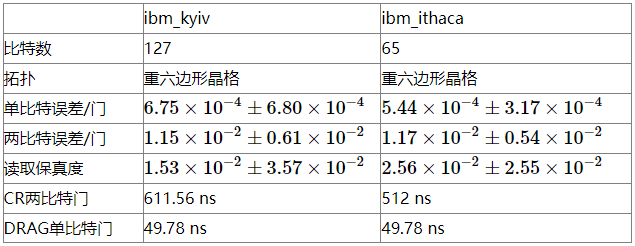
1) The median values of T1 and T2 are 287.87μs and 127.49μs respectively;
2) The average error of single bit is in the order of 10-4, and the average error of two bits is in the order of 10-2;
3) The reading fidelity is both in the order of 10 -2 magnitude.
03
Tasks handled by quantum computers
This article mainly uses the quantum processor ibm_kyiv to simulate the evolution of the 2-dimensional transverse field Ising model. The form of its Hamiltonian is:

where J is the coupling strength between nearest neighbors and h represents the global transverse field strength. The nearest neighbor relationship of this model is based on the structure of the quantum processor itself, as shown in Figure 1b below.
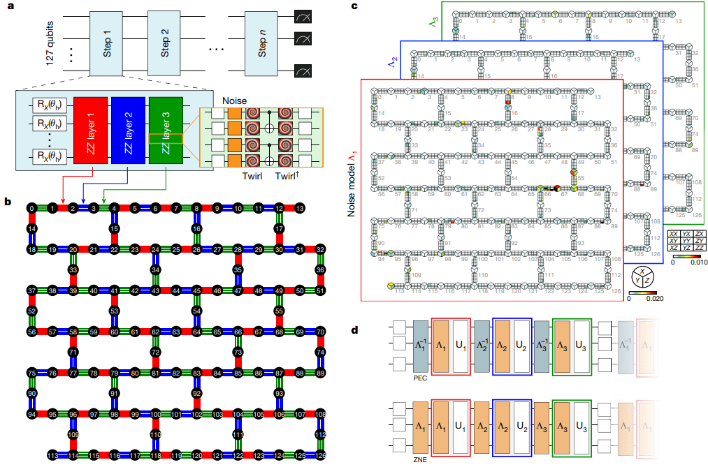
Figure 1 (Source: original paper)
This unitary evolution can be approximated by first-order Trotter decomposition,

For simplicity of implementation, it is selected here , so that the ZZ rotating gate can be equivalent to the following quantum circuit that only requires one CNOT:

We can divide the ZZ rotating gate into three layers in parallel according to the structure of the quantum processor itself, as shown in Figures a and b, which means that each step of the trotter contains three layers of CNOT gates. It can be seen from the figure that the CNOT gates required for each step of trotter are 144. When the quantum circuit performs 20 steps of trotter, that is, 60 layers of CNOT gates, it reaches the number of CNOT gates mentioned in the article, 2880.
04
** Noise Model
**
The noise model selected in this article is the Sparse Pauli-Linblad noise model.

The noise layer is shown in Figure 1 c,d. This article  adds layers in front of the original noise layer
adds layers in front of the original noise layer  to control the size of the noise. At this time, the total noise channel is
to control the size of the noise. At this time, the total noise channel is  , where G is the amplification factor
, where G is the amplification factor  . In zero-noise extrapolation (ZNE), the authors amplify the noise to different gain levels and use extrapolation to estimate zero noise.
. In zero-noise extrapolation (ZNE), the authors amplify the noise to different gain levels and use extrapolation to estimate zero noise.
Here, this article selects  viz
viz  . At this time, the entire circuit acts on the 0 state and does not change the quantum state, so
. At this time, the entire circuit acts on the 0 state and does not change the quantum state, so  the expected value obtained by using the observation quantity to measure is 1. Figure 2 below shows the experimental results at different noise levels, different circuit depths and after ZNE.
the expected value obtained by using the observation quantity to measure is 1. Figure 2 below shows the experimental results at different noise levels, different circuit depths and after ZNE.
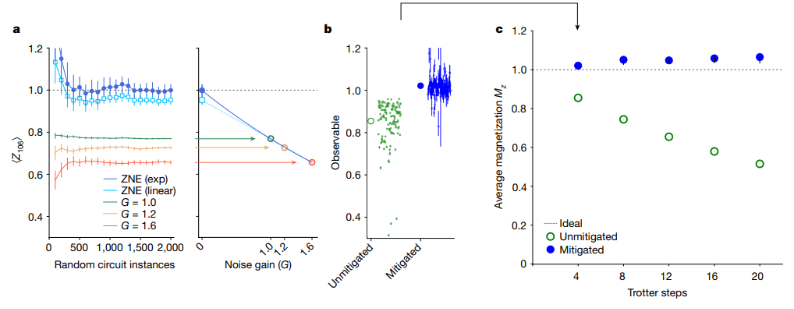
Figure 2 (source: original paper)
Figure 2a is  the result of performing 4-step trotter and observing it. It can be seen that ZNE can effectively reduce the impact of noise and obtain relatively accurate observation values. In addition, the effect of exponential extrapolation is generally better than linear extrapolation. Figure c shows
the result of performing 4-step trotter and observing it. It can be seen that ZNE can effectively reduce the impact of noise and obtain relatively accurate observation values. In addition, the effect of exponential extrapolation is generally better than linear extrapolation. Figure c shows  the relationship between the average value of each qubit observation and the circuit depth. The error of the results without error mitigation becomes larger as the circuit depth increases, while more accurate results can still be obtained after error mitigation.
the relationship between the average value of each qubit observation and the circuit depth. The error of the results without error mitigation becomes larger as the circuit depth increases, while more accurate results can still be obtained after error mitigation.
05
****Experimental Example
**
**
(1) 5-step trotter, 15-layer CNOT
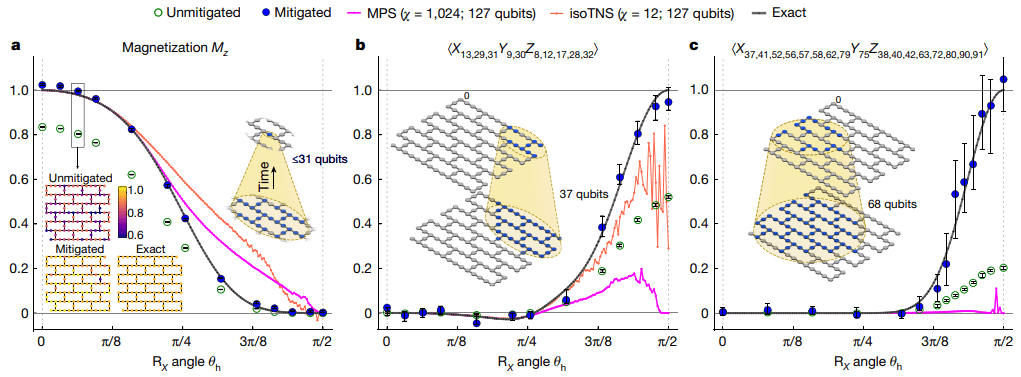
Figure 3 (source: original paper)
In this example, this article uses weight-1, weight-10 and weight-17 observations to measure the 5-step trotter's quantum circuit. The experimental results are shown in the figure. When performing classic simulations in order to obtain accurate solutions, the Light-cone and depth-reduced (LCDR) method is used here. It is divided into two parts. One part is to reduce the number of circuit layers that need to be simulated through the characteristics between quantum gates; the other part is to consider that the qubits related to the observation quantity A are local, which means that only a part of the qubits need to be considered. Evolution can then calculate the result of the final observation instead of all 127 bits.
As shown in Figure 3, the related qubit numbers of weight-1, weight-10 and weight-17 observations are 31, 37 and 68 respectively. It is worth noting that the simulation with 68 qubits is still beyond the capabilities of brute force simulations by classical computers. Therefore, this article introduces tensor networks, 1D matrix product states (MPS) and 2D isometric tensor network states (iso TNS), for simulation. Their complexity is

where  is the bond dimension and M is the number of bits.
is the bond dimension and M is the number of bits.
In this example, MPS needs to take the bond dimension  to simulate accurate results. It can be seen from the figure that the experimental results after error mitigation are closer to the real results.
to simulate accurate results. It can be seen from the figure that the experimental results after error mitigation are closer to the real results.
(2) Add a single-bit revolving door and 5-step trotter at the end
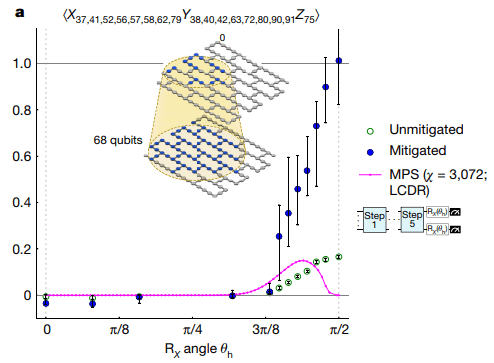
(Source: original paper)
This example differs from the previous one in that a layer of single-bit turnstiles is added at the end, which results in a reduced circuit depth of interruptions. The author uses weight-17 observations for measurement, and the number of qubits associated with it is 68. This is required  to accurately simulate this evolution process.
to accurately simulate this evolution process.
(3) 20-step trotter, 60-layer CNOT

(Source: original paper)
Although only weight-1 observations are used for measurement here, due to the large number of layers (20-step trotter), the number of qubits associated with it reaches 127. Therefore, it is very difficult to simulate this evolution process. Using MPS to simulate requires  accurate results. For example, there is a system that requires bond dimension extraction
accurate results. For example, there is a system that requires bond dimension extraction  . Then regardless of other factors, since the memory size required to store MPS is
. Then regardless of other factors, since the memory size required to store MPS is  , the memory required is 400PB.
, the memory required is 400PB.
Although there is no exact solution as a measure, these two examples still show that error mitigation techniques are still effective for quantum circuits of this size and depth.
06
Summarize
Many quantum algorithms are limited by the influence of noise in current quantum computers and cannot effectively demonstrate their advantages. However, current noisy quantum computers are not yet fully fault-tolerant. IBM's work this time achieved simulation of the 2-D transverse field Ising model on 127 quantum processors, showing that noisy quantum computers can still output reliable expectations. This provides new research directions for subsequent researchers.
A programmer born in the 1990s developed a video porting software and made over 7 million in less than a year. The ending was very punishing! Google confirmed layoffs, involving the "35-year-old curse" of Chinese coders in the Flutter, Dart and Python teams . Daily | Microsoft is running against Chrome; a lucky toy for impotent middle-aged people; the mysterious AI capability is too strong and is suspected of GPT-4.5; Tongyi Qianwen open source 8 models Arc Browser for Windows 1.0 in 3 months officially GA Windows 10 market share reaches 70%, Windows 11 GitHub continues to decline. GitHub releases AI native development tool GitHub Copilot Workspace JAVA is the only strong type query that can handle OLTP+OLAP. This is the best ORM. We meet each other too late.